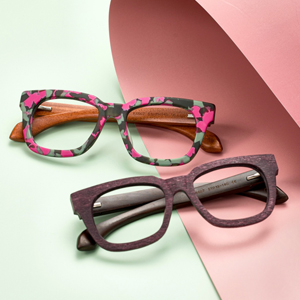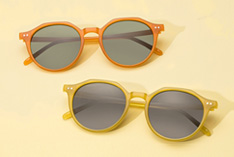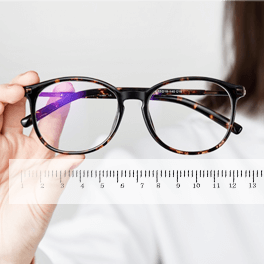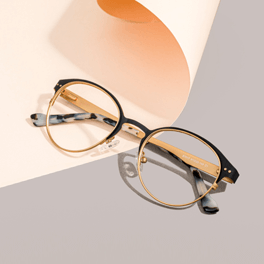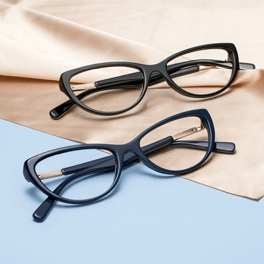FAQ
Quick Links
Eyewear Care & Eye Health
Cleaning your eyeglasses is a daily ritual. Correct cleaning steps can help you see clearly all day long.
√ Wash your hands
Wash your hands with a little dish-washing liquid or mild soap before you clean your eyeglasses.
√ Rinse your glasses
1. Run your glasses under a gentle stream of tap water that's approximately room temperature or a little warmer.
2. Apply only a few drops of gentle, lotion-free cleaning solution to avoid leaving any soap residue. Rub your glasses for a minute then.
3. For metal frames: Pay extra attention to the arms of the nose pads and the pads themselves.
4. For plastic frames: Clean the portion of the bridge in contact with your nose to remove built-up oil and sweat.
5. After that, rinse the glasses off thoroughly under the faucet.
√ Dry your glasses and clean the lenses
1. Use a dryer cotton towel to remove the majority of the water from the lenses and frame by patting dry. The dryer cotton towel should not come into contact with fabric softener or dryer sheets, or the debris can scratch your lenses.
2. After patting dry, clean the lenses with our microfiber cloth. Make sure the lenses aren't dry when you're cleaning them to prevent dirt or debris from being dragged across the surface.
To keep your glasses clean, follow these suggestions:
√ Wrap around your glasses with our microfiber cloth and place them upward in the glasses case when you're not wearing them.
√ Always clean your glasses when they are wet, cleaning a dry lens just increases the chances of the cloth simply dragging debris and smearing oil across the lens instead of picking it up.
√ Do not use anything containing alcohol. Not only can it damage the lenses themselves, but could also risk weakening some types of frames.
√ If you use bottled eyeglass cleaner, make sure that it's labeled 'safe for coated lenses'.
√ Wash your lens cloth once a week, and it will remove the dirt and deposits that have been built upon it.
√ Keep your glasses away from sunscreen, saltwater, and other chemicals that can damage the frame and the lenses over time.
√ When nose pads go yellow, it's time to replace them.
√ Using an ultrasonic cleaning device can be an option for an in-depth cleansing of your glasses. You can find them in several optical stores.
How you store your eyeglasses can determine how well your glasses hold up over time. Follow these suggestions for safely storing your glasses:
√ Wrap around your glasses with our microfiber cloth and place them upward in the glasses case.
√ Do not put your glasses on your head in case they fall down to break.
√ Use a hard case that's the right size for your glasses. If possible, place your glasses, in this case, every time you take them off.
√ Get a backup case so you have one on hand if your primary case breaks or if you forget your primary case.
√ Do not leave your glasses in a hot area, especially on the dash of a car parked in the sun. The heat can warp the frame and damage the coatings.
√ Do not put your glasses into a bag of any kind without first placing them in a hard case, or it can easily scratch your lenses.
1. Advantages of rimless glasses
Rimless glasses are lightweight and comfortable. Because they accent your natural beauty, your features won't get buried under a pair of rimless glasses. If you're leaning toward rimless glasses, consider the benefits compared to rimmed frames:
RIMLESS GLASSES | RIMMED GLASSES |
Lightweight | May feel heavy or bulky |
Lets your natural beauty shine | May overpower your features |
Less noticeable than framed styles | May attract unwanted attention |
Trendy and new | Been around for many years |
No border while reading or driving | Frames may partially obstruct your view |
Available in numerous styles | Available in numerous styles |
2. Disadvantages of rimless glasses
- May break easily
- Easy to smudge or streak
- May cost more than framed styles
- More prescription lens limits as compared to rimmed glasses
- The natural look may disappoint eyewear users who prefer a bold style
3. How To Take Care Of Rimless Glasses
* Always store them in a case
The lack of a supporting frame makes rimless glasses easier to break. Protecting your eyewear from every-day knocks and scratches, glasses cases are super-important for keeping your specs in top condition. When you take off the glasses, they must be wrapped up by glasses clothing, and put into the glasses box, in order to avoid being scraped or misshapen. Please do not hang the rimless glasses on your clothes or bags, and do not wipe the lenses with your clothes or T-shirt. If you are just setting them aside for a bit, make sure to place them face up to protect the lenses from getting scuffed from the surface.
* Always handle your glasses with both hands
Whenever you need to remove your glasses, make sure you carefully do so using both hands. Taking them off with one hand can eventually lead to them loosening or sitting crooked on your face. It's easy to get rimless glasses dirty because they have so much lens space, too. Try to remember to take your glasses off by gripping the sides with both hands rather than the nose piece. This may help you cut down on smudges and streaks.
* Take care when cleaning them
We include a small cloth with all orders for cleaning your lenses. Make sure to use this and not your clothes as clothing contains tiny fibers that can permanently scratch the lenses - the same applies to using tissue or paper towels. When cleaning rimless frames, make sure to be extra careful by holding them by the edge of the lens rather than the bridge.
* Other tips about rimless glasses -
- Place the eyeglasses in dry and cool places to protect the coating on the lenses.
- Do not wear rimless glasses to do sports, because it is easy to fall after sweating, and then might be broken.
- The rimless glasses can install a plastic clip on the end of the glasses' legs, so the glasses can be hooked to the ears' back, and is not easy to fall.
Establish good habits for wearing your glasses, especially if they have a prescription.
√ Avoid putting your glasses on your head
When you take your glasses off, do not simply push them up on top of your head. The top of the head is generally wider than the face and setting your glasses there can widen the frames.
√ Use both hands
When you remove and put on your glasses, use both hands, one on either temple arm. This motion encourages correct alignment and minimizes changes to the fit of your frames over time.
Anti-fog solutions are useful for reducing and preventing fog from forming on a variety of surfaces. Typical applications for anti-fog lens treatments include prescription glasses, sunglasses, safety glasses and goggles, and safety shields.
You don't need your glasses in the shower as they fog up very quickly in the bathroom, and you still can't see clearly with them. Additionally, you don't have to see as far as usual in the bath.
High temperature and humidity may deform the frame and damage the lenses and coatings.
When the cornea and the lens of the eye don't work together as they should to focus on an object, the eye muscles must work harder to see clearly - this causes the strain that results in symptoms such as sore eyes, blurred vision and, commonly, headaches.
The suggestions below can provide sore eyes relief:
√ Allow your eyes to rest: reduce the use of computers and televisions.
√ Use a moist warm compress on eyes: relax the muscle and increase circulation
√ Use non-medicated eye drops: relieve the pain and soreness (do not use frequently)
If you spend most of your day on a computer, tablet, or smartphone, all this screen time can make your eyes feel tired and dry. There are some solutions to this.
√ Take frequent breaks from your computer screen
You can reduce computer eye strain by following the 20/20/20 rule. Every 20 minutes, look away from the screen for at least 20 seconds. When you look away, focus on an object that is at least 20 feet away from you.
√ Use non-medicated eye drops when taking a break if needed
Non-medicated eye drops can help keep your eyes moist and focus properly. But it cannot be a substitute for the 20/20/20 rule and cannot be used very often.
√ Invest in computer glasses/blue light blocker
Computer glasses (blue-light blocking glasses) can help decrease blue light, especially when working on the computer all day. You can have a pair of that even if you don't wear prescription glasses.
*Click here to know more about blue-light blocking glasses.
√ Do some office changes to reduce digital eye strain
Some office changes can help alleviate eye strain. Improve your office lighting when using the computer. Keep your monitor bright and reduce the glare on the digital screen. Use an optimal viewing distance which is 20-28 inches (50-70 cm).
√ Sleep well and eat healthier
After a long-time day of work, a good rest can help relax your brain and eyes. Good eye health starts with the food on your plate. Nutrients are good for the eyes like omega-3 fatty acids, lutein, zinc, and vitamins C and E.
Taking glasses on and off shouldn't be a problem if you function fine without them. Especially once you reach the reading glasses age of about 45, you will need different lenses for different distances. These may be different glasses, or they may be bifocals or progressives.
However, if you take off your glasses and squint to see when you should be wearing them will cause unnecessary eye strain.
Younger patients, especially those under 16, should follow eye care providers' advice. Prescriptions for them are usually designed to prevent or treat lazy eye, help with eye alignment, or prevent growing eyes from worsening.
For centuries, people have promoted eye exercises as a 'natural' cure to improve eyesight. There's very little credible scientific evidence suggesting that eye exercises can improve vision. However, exercises can help with eyestrain and may help your eyes feel better.
Age-related macular degeneration (AMD) is one of the leading causes of vision loss and vision impairment in the world.
Studies have shown that diet, smoking, and body mass index might affect the chances of getting AMD. Eating healthy and maintaining an active lifestyle can contribute to healthy vision.
Food choices that can keep your eyes healthy: leafy vegetables, food rich in omega-3, citrus, zinc-rich food.
• Not Wearing Your Sunglasses
Sun's harmful UV and high-energy visible (HEV) rays can prematurely age and damage your eyes and eyelids. To protect your eyes, make sure you wear sunglasses to block the sun's UV rays when outside the door.
• Smoking
Smoking harms almost every part of your body, including your eyes. Studies have linked smoking to eye diseases. The good news is that quitting, no matter how old you are, can help reduce the risk of developing a severe eye condition.
• Rubbing Your Eyes
The skin around your eyes is very delicate. Rubbing your eyes can break the tiny blood vessels that are under the skin's surface. Regular eye rubbing over an extended time can lead to Keratoconus, which causes a thinning of the cornea and results in the cornea losing its shape.
• Not Getting Enough Sleep
Not getting enough rest can cause red eyes and dark circles, eye twitches, dry eyes, and blurry vision. It cannot only affect your vision but your overall health as well.
• Not Eating Properly
Colorful fruits and vegetables have essential vitamins, minerals, and fatty acids contributing to your optimum eye health.
• Not Drinking Enough Water
Drinking little water and eating a high-sodium diet every day can cause your body dehydrated. It will result in dry eyes, red eyes, and puffy eyelids.
• Not Having Regular Eye Exams
Comprehensive eye exams can detect vision problems, eye diseases before you even realize that they exist. Regular eye exams are necessary even though for those who don't have vision issues.
Poor eyesight definitely runs in families. Recent studies have shown that if both your parents are nearsighted or farsighted, you will have about a 1 in 3 chance of being nearsighted or farsighted too. If one of your parents has a vision condition, you will only have a 1 in 5 chance to get it.
Astigmatism can run in families. If you have astigmatism, your children may have it as well. This condition often occurs with other vision conditions such as nearsightedness or farsightedness.
Most eye doctors will recommend adults complete eye exams at least once every two to three years. Having your baby's vision tested at six months of age is recommended as well. The American Academy of Ophthalmology (AAO) and the American Optometric Association (AOA) also advise that all infants, preschoolers, and school-age children be screened for vision problems.

